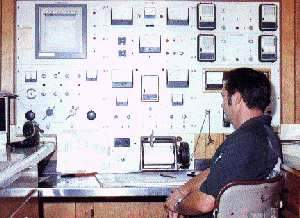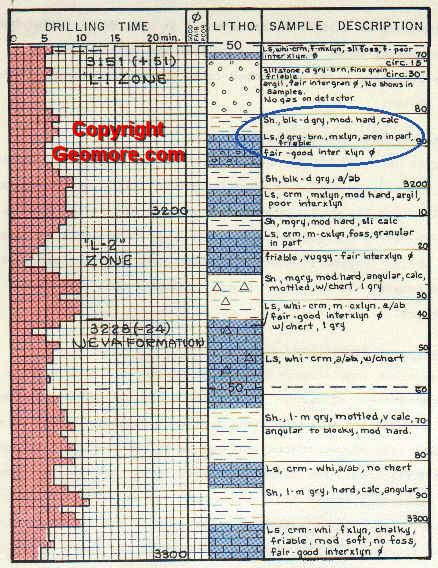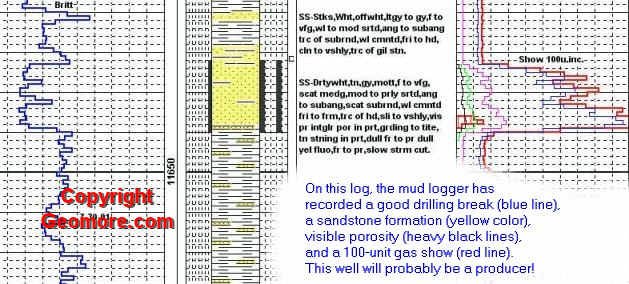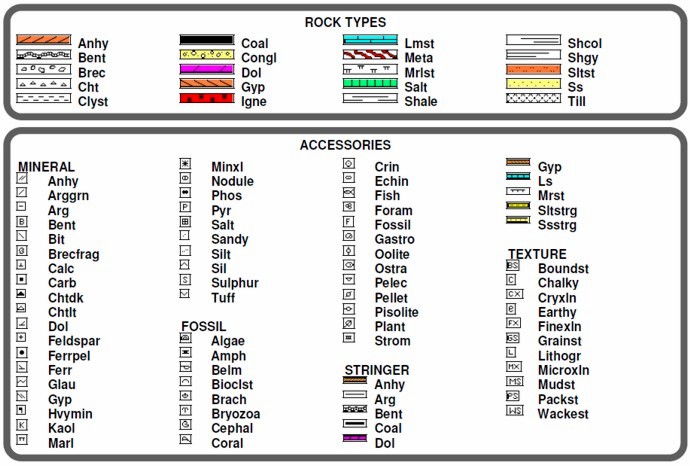The Mud Log

The Mud Logger Monitors The Well for the Geologist
The mud log is an important record of drilling activity prepared by the petroleum geologist’s assistant during the drilling of a well (the assistant is called a mud logger). The mud log contains the entire geological record of the drilled hole, along with other important parameters such as drill time, mud characteristics, and oil and gas shows. If the logger sees any oil in the well samples, it will be very clearly noted on the mud log. Any indication of oil or gas is called a show, and the shows are one of the important things the mud logger will detect.
Below is an old-style mud log, drawn by hand. As the well cuttings come up from the bottom of the hole, they are examined and identified. The mud log is updated each day of drilling. The mud log and the electric logs (which will be run after the hole is drilled) are the two most important items the PG needs to evaluate the potential well.
 On the right side of the mud log, the mud logger records his interpretation of the rocks drilled. There are two types of interpretation shown, a drawing down the center of the log (abbreviated litho), and a sample description.
On the right side of the mud log, the mud logger records his interpretation of the rocks drilled. There are two types of interpretation shown, a drawing down the center of the log (abbreviated litho), and a sample description.
Let’s talk first about the section called “litho” (lithology, or rock type). The logger uses standard symbols and colors to illustrate the different kinds of rocks, textures, fossils, and bedding. Limestones are shown as blue blocks on the log, shales are shown as short black horizontal lines, and sandstones/siltstones are shown with a dotted pattern. Chert is shown as triangles. He looks at the small well cuttings under a microscope to figure out what the rock types are. It takes a lot of experience and know-how to figure out what rocks are being drilled just by looking at the tiny well samples.
The sample description is a more detailed summary of what the logger sees. Abbreviations are used because so much detail must be recorded. For example, look at the words inside the blue circle. It’s a little hard to read, but it says “shale, black to dark-gray, medium hard, calcareous (containing limestone, or calcium carbonate).
Right below the shale is a limestone described as dark-gray to brown, medium-crystalline (medium grained), arenaceous (containing quartz sand), friable (breaks apart like sand), with fair to good inter-crystalline porosity.
The mud logger has also picked a couple of formation tops, and placed them on the left side of the log. These are the L-1 and L-2 Zones, and the Neva Formation. Mud loggers are very often the most experienced workers at interpreting well samples in a given area, and they are often able to pick up obscure tops or markers the geologist is unfamiliar with.
Mud Loggers Use Computers These Days
These days, most mud logs are made with a computer. The mud logger still does all the sample and gas-monitoring work he did before, but he no longer needs to be a draftsman. Here is an example of an older one:

Computer-Drawn Mud Log
Other data that will be posted on the log are the chemical properties of the mud (viscosity, weight, salinity, etc.), drill string trips that are made in or out of the hole (when the entire length of pipe is pulled from hole to replace the bit, or do other work), records of gas flares, the presence of oil in the mud pit, or any other circumstances that might be noticed while the well is drilling (like screw-ups).
On the left side of the log, drilling time is recorded. The rig keeps track of the drilling time and a lot of other parameters using a recording clock device known as a geolograph. The geolograph makes a precise record of the time it takes the drill bit to drill the rock. Drill-time is recorded in increments of 2 feet. The numbers across the top indicate how long it took to drill that two feet, in minutes per foot. For instance, the depth from 3200′ to 3202′ (1 block), drilled at 7 minutes per foot, or a total of 14 minutes for the two feet. Drill time is incredibly useful in picking out zones that may be productive, or correlating the electric logs to the mud log.
Making a chart of drill time is very important, because it gives the PG one more hint to help figure out what rocks are being drilled. Remember that the well has not been logged with wireline tools at this point. Notice that in this well, the shales tend to drill “slow” (5-10 minutes per foot), while the limestones drill “fast” (2-6 minutes per foot — same for clean sandstones). This is because the soft shales are ground into a thick, sticky mud by the drill bit, and “ball up” on the end of the bit. This causes the bit to cut through the rock slower, which slows the penetration rate.
Usually the slowest-drilling formations will be extremely hard, well-cemented, non-porous sandstones. For these types of formations, a special (and expensive) bit called a PDC bit, is sometimes used, if the formation is thick enough to justify running one in.
Porous sandstones and limestones don’t ball up, so they usually drill really fast…just as seen on this log. In fact, one of the things a petroleum geologist likes to see is a good “drilling break” in his target sand. This means the sand drills very fast (3 minutes per foot or less), indicating it is soft or porous.
At the right is a picture of the complex mud-monitoring equipment inside a portable mud-logging trailer. This equipment’s main job is to detect oil and gas in the mud.
The mud log will be used in combination with the electric logs run on the well to make a decision about whether to complete the hole (try to produce oil or gas from it) or plug the well. Mud logs are an extremely important tool to the petroleum geologist.
The mud logger often acts as a spy for the geologist. It is especially helpful when the mud logger notices some action being taken at the rig that he does not believe to be correct, and notes it on the log (and calls the geologist). For example, the geologist may have ordered that drilling samples be taken every 10 feet, but the mud logger notices that samples are collected randomly, or not at all. The mud logger has to watch out for sample “stacking.” Stacking is a term used when the sample collector (normally the lowest status drilling hand, or “worm”) skips a bunch of samples while he is taking a nap behind the mud hut. The worm later collects several samples at once, and falsely labels them with the correct intervals. The “worm” thinks he is pretty clever — that all samples look the same. A good mud logger can easily pick up on this sort of mischief.
Many things can go wrong while drilling. If something has been done that can affect the geologist’s interpretation of the borehole, it is extremely handy when the mud logger is a dedicated tattle-tale.
Common Symbols Used in Mud Logging
Below is a chart of common symbols used on mud logs:

Mud Logging Symbols
